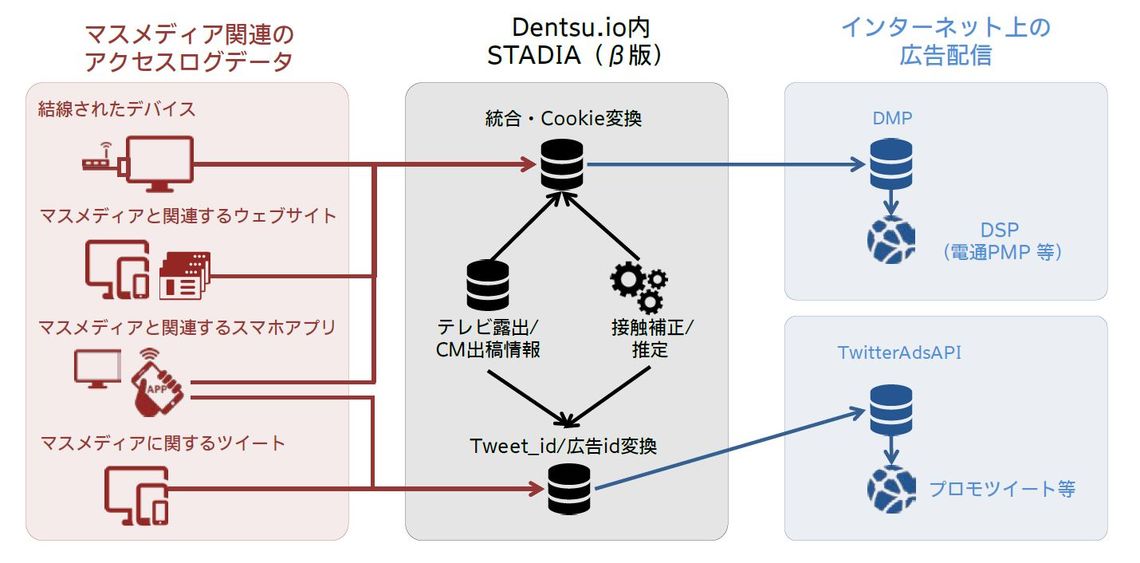Dentsu Inc. Develops Integrated Marketing Platform "STADIA (β Version)" to Maximize Synergy Between Mass Media and Web Advertising
On March 4, Dentsu Inc. announced the development of "STADIA (β)" (STADIA Beta), an integrated marketing platform that maximizes the synergistic effects between mass media and web advertising by cross-referencing access logs estimating mass media exposure with web audience data (Cookie ID/Advertising ID/Twitter User ID), thereby providing new value.
Since October 2013, the company has been researching integrated marketing utilizing access logs that estimate mass media exposure, aiming to practice and manage integrated offline and online marketing. This time, it expanded the functionality of its cloud-based high-speed data analysis platform "Dentsu.io" to build "STADIA (beta)" within Dentsu.io. This enables the aggregation of access log data estimating mass media exposure, including TV viewing, and its integrated analysis with audience data. This allows web ad delivery based on offline exposure.
In recent years, it has become possible to identify or estimate mass media exposure through access logs, provided users grant permission and anonymization is applied ※1. Data on mass media exposure from internet-connected devices, along with various mass media-related data collected via websites, smartphone apps, Twitter, and other platforms often used simultaneously or in conjunction with mass media, can now be gathered.
By utilizing the newly developed "STADIA (beta version)," it becomes possible not only to deliver web ads aligned with societal moments based solely on traditional media exposure information and panel data, but also to deliver web ads to segments defined based on each individual's actual contact with mass media. This enables the setting and improvement of new integrated marketing KPIs.
As part of its efforts to implement integrated marketing through the full-scale operation of "STADIA (beta version)," the company has commenced a proof-of-concept experiment for "Viewing Log Targeting." This delivers web ads based on TV viewing behavior and program preferences. This involves delivering ads via a DSP (Demand-Side Platform) to identified commercial viewers based on actual viewing history obtained from internet-connected TV sets with user consent, and viewing information obtained from voice recognition in IPG Inc.'s electronic program guide smartphone app "G-Guide Mobile" ※3 . It also involves delivering Promoted Tweets (a collective term for ads explicitly labeled "Promoted" on Twitter) via the Twitter Ads API※4 to viewers estimated based on Twitter posts related to TV. The goal is to improve integrated marketing KPIs through PDCA cycles during or after the campaign . 5. The initiative aims to improve integrated marketing KPIs through PDCA cycles conducted during or after the campaign.
Furthermore, to maximize the synergistic advertising effect between the quality of Odin's identified or estimated audience and the quality of web media ad slots, the primary ad delivery destination via DSP will be Dentsu Inc.'s proprietary PMP (Private Marketplace), centered on limited, high-value premium ad slots.
Moving forward, the company will further enhance the synergy between mass media and web advertising by expanding and improving the accuracy of media behavior data, as well as expanding the network of ad delivery destinations based on access log data. This will drive advanced integrated marketing that bridges offline and online, delivering unprecedented new value.
<Main Features and Concept Diagram of "STADIA (β)">
◇Key Features
・Functionality to analyze mass media exposure and viewer preferences
・Function to convert and expand mass media access log data into cookies and advertising IDs
・Function to connect with various Data Management Platforms (DMPs)
◇Concept Diagram

※1: Regarding access logs used to estimate contact with mass media being provided
Data is collected only when users have enabled participation in the proof-of-concept survey. This data contains no personally identifiable information and is not structured in a way that allows identification.
※2: KPI
An abbreviation for Key Performance Indicator, referring to particularly important metrics set to monitor specific business processes for achieving objectives.
※3: Rovi, G-GUIDE, G-GUIDE MOBILE, and G-GUIDE-related logos are trademarks or registered trademarks in Japan of Rovi Corporation and/or its affiliates.
※4: DSP
Demand-Side Platform (DSP) is an abbreviation for a web advertising tool used by the demand side (advertisers = the demand side) for ad delivery. It provides functions to help advertisers maximize advertising effectiveness.
※5: Twitter Ads API
A mechanism provided by Twitter for ad delivery. It enables data-driven Promoted Tweets based on analytics that cannot be achieved through the standard management interface.
Dentsu Inc. News Releasehttp://www.dentsu.co.jp/news/release/2016/0304-008689.html
Was this article helpful?